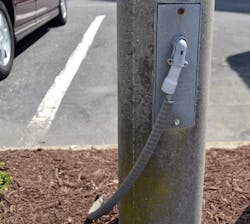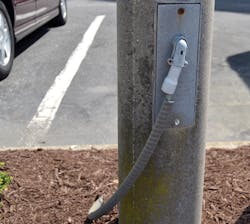Creative Conduit Cluster
Score two points for creativity, but subtract several for multiple Code violations on this installation. Let’s begin with Sec. 300.15, which requires fittings to be used only with the wiring methods for which they are specifically designed. The flexible metal conduit (FMC) connector in the photo is certainly not designed to be used with PVC. The next problem is the use of the FMC connector itself, which is not permitted for this exterior wet location as specified in Sec. 348.12(1).
Moving on, note the improper use of the coupling on the PVC pipe to connect to the liquidtight flexible nonmetallic conduit (LFNC). This violates the intent of Sec. 356.42, which requires fittings listed for use with LFNC to be used. Next on the violations list is Sec. 300.12, which requires raceways to be “continuous between cabinets, boxes, fittings, or other enclosures or outlets.” Lastly, the use of LFNC for this specific application is questionable, since Sec. 356.12(1) does not permit it to be used where subject to physical damage. It appears the LFNC has been positioned in an area where it could be stepped on.
Bad to the Last Drop
A leaky water pipe in the wall above this box caused some serious damage to the box and the devices inside it. As you can tell, this situation went unnoticed for a long time before being discovered. Fortunately, the problem was discovered before anything really bad happened.
Section 110.12(B) prohibits any damaged parts that may adversely affect the safe operation or mechanical strength of the equipment. Needless to say, this equipment is not in any condition to be operated safely, and must be removed from service and replaced with new equipment.
For this particular installation, I removed and replaced the NM cable inside the wall, which had also been soaked. Furthermore, I installed all new boxes and devices to replace the damaged ones. Of course, I made sure the leak was fixed before I did any rewiring.
Water leaks and floods can cause significant damage to electrical equipment. Sometimes, this damage may not seem very apparent, and electricians may want to just “dry out” the wires and equipment instead of replacing them. However, water can carry contaminants that could deteriorate equipment and wiring over time. It’s usually best to replace water-damaged components. In this situation, there was no question about whether or not to replace the components in this photo.
About the Author

Russ LeBlanc
Owner
Russ started in the electrical trade as an apprentice in 1985. He worked his way up to become a Journeyman Electrician and then eventually became a Master Electrician and Licensed Construction Supervisor. In 1999 Russ become an Electrical Instructor for The Peterson School of Engineering in Massachusetts where he developed his passion for teaching, and quickly became Department Head of Electrical Instruction. Russ has taught thousands of apprentices, electricians, engineers, inspectors, and other electrical professionals during his career as an instructor. He continues to provide electrical professionals with Electrical Code seminars, Arc-Flash Awareness training seminars and educational material through his LeBlanc Consulting Services in North Reading, MA whose specialty is educating electricians. He has been an active member of the NFPA Electrical Section and has authored hundreds of National Electrical Code proposals and comments which have become Code rules to improve the safety for the electrical industry. Russ is also an IAEI certified Electrical Inspector.
Please visit www.russleblanc.net for more information.


